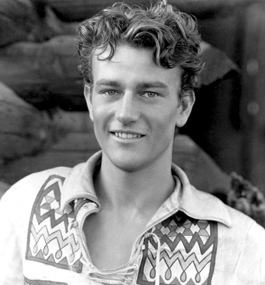Saddling Up with the Duke

Courtesy Insight Editions
COWBOY HERO: A 1930 publicity still, taken around the time studio executives gave Marion Morrison his new name, John Wayne.
by Susan Piland
He never legally changed his given name, Marion Morrison. He thought his epitaph should be “Feo, Furete y Formal” (“Ugly, Strong and Dignified”). He died in 1979 at age 72, yet he’s been voted into the top 10 of every Harris Poll Favorite Movie Star list since the list began in 1994.
He is John Wayne, and a handsome new book gives fans an inside look at the actor, father and friend behind the silver-screen image.
“John Wayne: The Genuine Article” (Insight Editions, 2013) is written by Michael Goldman ’81, a veteran entertainment-industry journalist and author of six books, including last year’s “Clint Eastwood: Master Filmmaker at Work.”
The 160-page volume bursts with behind-the-scenes stories and photos. Adding to the abundance are loose-leaf facsimiles of dozens of archival documents — a portion of the “True Grit” script showing Wayne’s handwritten notes, his 1981 California driver’s license, a cast time-schedule from the 1956 film “The Conqueror” — affixed inside the book in faux scrapbook style.
Notably, Goldman includes excerpts from an uncompleted autobiography by Wayne that the author discovered in the actor’s archives, revealing for the first time Wayne’s first-person account of his early years.
Letters written to and by Wayne are another highlight. Director and longtime friend John Ford was a faithful correspondent; the Ford-Wayne letters reprinted here are irresistibly warm, chatty and funny.
A late bloomer, Wayne didn’t break out as a major star until he got the lead in the Ford-directed “Stagecoach” (1939), released when the actor was 31. He went on to make more than 140 films, such as “Red River” (1948); “The Searchers” (1956); and “True Grit” (1969), for which he won a Best Actor Academy Award.
In addition to showcasing the movie work, Goldman offers intimate glimpses of his subject’s life away from the set. Wayne hired a young Temple Grandin to design a humane cattle chute for his Arizona ranch. He collected Native American kachina dolls. When The Harvard Lampoon wanted to roast him in 1974, this conservative Republican accepted without hesitation, riding delightedly into Harvard Square in a U.S. Army armored personnel carrier.
Produced with the backing of the family-run John Wayne Enterprises — with an admiring foreword by President Jimmy Carter — the book manages to shred stereotypes about Wayne held by both the right and the left. Even a skeptical reader closes “John Wayne: The Genuine Article” persuaded that this icon was something rare in Hollywood: a real mensch.
